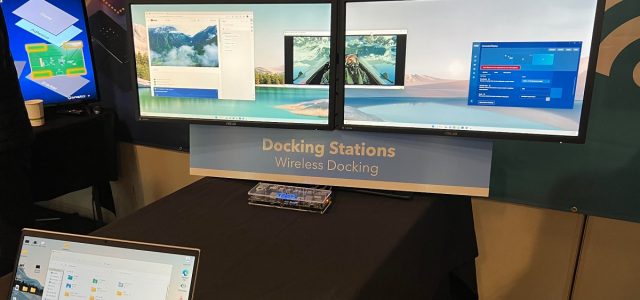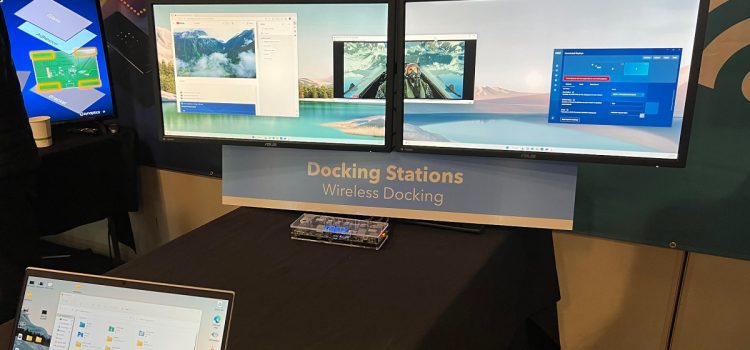


Connect with gaming and metaverse leaders online at GamesBeat Summit: Into the Metaverse 3 this February 1-2. Register here.
The semiconductor industry has gone through a whipsaw in the pandemic, with a couple of years of parts shortages causing product delays, inflation, and long waits for buying products. We’re now in a global economic downturn that may flip things around and ease the shortage.
Amid this turmoil, Synaptics has been pushing ahead with improvements in chips that are going into a wide variety of products, including PC monitors, virtual reality headsets, and cars. Its touch-sensor products go into just about anything that you control with a finger touch. And more of those products are getting infused with artificial intelligence.
Using AI at the edge, Synaptics image sensors can detect whether someone has fallen. The company’s chips enable wireless docking between monitors and laptops. It makes sensors that detect environments for VR headsets, and components for universal wired docking for laptops.
One of the things it’s helping turn into a reality are the new wireless-docking monitors that will be on display CES, the big consumer electronics trade show in Las Vegas in early January. I talked to Michael Hurlston, CEO of Synaptics, in an interview during a demo day at the company’s headquarters in San Jose, California.
Event
GamesBeat Summit: Into the Metaverse 3
Join the GamesBeat community online, February 1-2, to examine the findings and emerging trends within the metaverse.
Here’s an edited transcript of our interview.

VentureBeat: Do you detect much change in the market in terms of the semiconductor shortage?
Michael Hurlston: Most definitely, yes. You’ve been around the business for a long time. At the end of last year, the last calendar year, like everybody we were in a scramble mode for chips. The shortage and the semiconductor supply chain problem is well-documented. We were in the middle of that. Probably by the summer, maybe late summer, we started to see significant easing, and into the fall very significant easing. A lot of inventory has been built up. We’re going to have to work through that. It’s been relatively easy for us to get supply now. Not perfect. There are still some areas where there are bubbles. But generally speaking I would say the supply chain crunch is over for the most part.
VentureBeat: There’s a good side to that in that products get out the door now for the end users. The tougher side is maybe they’re not commanding the same prices.
Hurlston: Pricing is a conversation. Again, I’d say generally it’s held up. The bigger problem is–the chip industry as a whole, just in round numbers as an example, let’s say it takes a thousand parts to make a phone or a PC. The PC guys, the phone guys had 998 of them. They were looking for two. But they kept buying the 998 thinking the two were going to come in. What’s happened over the last few months, now demand has equalized at least. They’re sitting on lots of sets of 998 components. When they get the two they’re building, but they don’t need any more of the 998. That inventory problem is going to take quite some time to work itself out as they get the last components to complete the kit and ship out a product. In most cases we’re on the side of the 998. There’s a pretty big inventory problem that I think needs to get worked through.
VentureBeat: Does this tell us we still have a lot of old-fashioned problems? Inventory being one of those.
Hurlston: Inventory is a pretty big issue. Everybody needed better tools to understand what was being shipped in, what was ultimately being consumed. We were asked by our investment analysts over and over again. Is there double ordering? Are people taking too much? I don’t know that we had the instrumentation we would need to say yes or no. The truth is it’s a combination of things. One, demand has definitely waned a bit. But certainly there was more shipped in than was ultimately needed.

VentureBeat: I tried on that new Meta headset, the Meta Quest Pro. It has something like 10 cameras in it. It has all these extra sensors that the other ones didn’t have. It feels like that’s a trend that Synaptics must love, this need for more sensors.
Hurlston: It’s interesting. My concern now, actually, is that we’re going to whipsaw right back to a capacity constraint environment in a quicker amount of time than we ever have before. The macro trends are still absolutely there. There’s more semiconductor content going into more things than ever before. Your example is a good one. The Meta goggles have a huge number of sensors. That’s great for us. We do a lot of these sensors. There’s a tremendous amount of display content. We make the display drivers.
A lot of that, as you know, is on trailing nodes. The Qualcomm processor that drives the Meta glasses, that’s in an advanced 7nm process. But the rest of the goodies, the sensors, they don’t need to be, nor will they ever. The capacity problem, the capacity buildout at 28nm and up, nobody ever built the capacity. The only thing that’s changed is that the demand has come down. My worry is we’re going to whipsaw right back into a capacity constrained environment once this inventory situation equalizes.
VentureBeat: Do you have a dog in the fight when it comes to ARM-related things? Especially when it comes to RISC-V.
Hurlston: Not really. We use ARM. We also use RISC-V. We’ve had a pretty good experience with RISC-V. One of the interesting things is our touch devices are on our own homegrown processor. We feel like because customers are more familiar with third-party processors, we’re going to move off of that. Right now we’re in an evaluation between the two. We would probably end up going with RISC-V as opposed to ARM, simply because of cost. ARM is very good, but the costs are quite high. In many instances now RISC-V has a competitive product out there that we can use.
VentureBeat: The interesting pitch for RISC-V is that it’s geopolitically neutral. The different nations of the world are open to it.
Hurlston: I would say that ARM could make that argument too. They’re relatively equally geopolitically neutral. I’m not sure that’s necessarily an advantage. But I do think that the big issue is cost. ARM has become a de facto standard in many cases, and they know it. Their costs are probably a little higher than I’d like to see.
VentureBeat: As far as your technology here, is there a common thread you see among some of these CES products, a common theme from Synaptics?
Hurlston: We have a lot of different technologies, as you’ve seen. A lot of different end markets, as you’ve seen. We play in PC. We play in VR goggles. We play in automotive. There’s a lot of different things we do. Our job is to bring those together into platforms. That’s what we’re trying to do. Focus areas for us, where we’re bringing multiple pieces of Synaptics technology, include VR headsets. We’re excited about that. Automotive. We can bring different parts of our technology into that.
And then the clean workspace. You saw a demo out there on wireless docking stations. We think we can do wireless monitors, which has been tried a hundred times. I know you know that. The difference we bring is we have a proprietary video compression algorithm that can generate really low latency and enough compression that you can do mouse movements, which is required on a monitor obviously, at the same time as you’re doing high-definition video. We think that finally catalyzes the idea of the wireless monitor. We’re going to push into that clean workspace using two or three different technologies we have: the wi-fi, video compression, video playback. We’ve assembled a war chest of technologies. Now, as we go forward over the next few years, we’ll try to boil them into a couple of platforms or initiatives that make more sense out of things.

VentureBeat: How many people are here now?
Hurlston: Here there are roughly 400. The whole company is about 1,800.
VentureBeat: Are you back at work at the office?
Hurlston: For the most part. It’s been interesting. We actually got people back into the office fast. We were back in May of 2020. We had two months of work from home and then got everybody back in, at least in hybrid, almost right away. We’ve had fewer issues with some of the pushback you see around people coming back to the office. People got used to working remotely. We always had–very quickly we got to a hybrid model. That’s been helpful now in keeping that, not having employees rebel as we try to get them back to the office.
Remote work has its challenges. There are good things. You’ve been in the bay area a long time. Cutting out an hour commute each way is a good thing. But there’s been pretty significant downsides. The collaboration the engineers have is way down in a remote situation, and just productivity overall. The average worker probably puts in more time, but you have a mix of things. People have certainly used it as an opportunity to take more time away from the office than they would if they were actually in the building.

VentureBeat: Do you feel like there’s a generally brighter outlook as far as getting through some of these crazy years we’ve seen? Are we heading back to a kind of normal market, the macro economy aside?
Hurlston: You know it better than I do. We had two years of crazy positive, where you had a huge shift of spending from services to goods. We were beneficiaries, because a lot of the remote work–we have goodies that go into headsets and docking stations and PCs. As people were replicating their office environment in the home, we got a nice uplift. We’re getting a bit of uplift as things come back, but the reality is that a lot of our business is consumer-facing. We’ve seen pretty significant reset over the last quarters. I’d expect that to be here for another couple of quarters, where demand is going to be lighter than average. It was better than average for two years. It’s going to be lighter than average for the better part of a year. Then we’re going to get to an equilibrium, barring another massive unforeseen event.
As I was saying earlier, my biggest concern is we haven’t solved the underlying capacity problems in trailing edge foundry. When we get back to that equilibrium point, I think we’re going to be in a supply constrained environment again.
We’re excited about the technologies for CES, though. Last year we kind of half went. We had a booth, and then at the last minute everyone was canceling. We tore the booth down. Then we had a room with a couple of chairs in it. This year I think it’ll be full force. This is all going to be replicated in our CES booth. We’re pretty excited about having people come by and take a look. I think our technology ends up showing pretty well.
GamesBeat’s creed when covering the game industry is “where passion meets business.” What does this mean? We want to tell you how the news matters to you — not just as a decision-maker at a game studio, but also as a fan of games. Whether you read our articles, listen to our podcasts, or watch our videos, GamesBeat will help you learn about the industry and enjoy engaging with it. Discover our Briefings.
